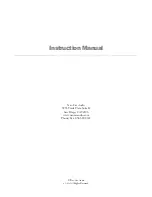
en – Original Instructions
18
Installation, Operation and Maintenance Manual
4.3
Hydraulic connection
WARNING:
All the hydraulic connections must be completed by a technician possessing the technical-
professional requirements outlined in the current regulations.
WARNING: Excessive system pressure hazard
Piping must be sized to ensure safety at the maximum operating pressure.
The maximum pressure value of the pump is listed on the data plate. Do not exceed this
pressure.
WARNING: Excessive system pressure hazard
The heating of water and other fluids causes volumetric expansion. The associated forces may
cause failure of system components and the release of high temperature fluids.
This can be prevented by installing properly sized and located compression tanks and pressure
relief valves.
4.3.1
Guidelines for the hydraulic system
Recirculating pumps installed in the return line
•
Before starting piping work shut off the water to the house and drain the affected sections of
the plumbing lines and the water heater if necessary.
•
Select the sink under which to connect the recirculation line (the sink where the hot water
takes longest to arrive, which is usually the sink farthest from the water heater).
•
Use 1/2" tubing for the recirculation line.
•
Connect the return line with a tee fitting at the last faucet/taps riser, as close to the end of the
hot water supply line as possible and run the line back to the water heater.
•
Decide on the course of the recirculation pipe (also determining the length of the pipe
required) and whether the return line should be connected to the water heater cold water
inlet line (tee fitting required) or to the bottom water heater drain valve ("Y" type fitting
required to fit to existing drain valve outlet). See Figure 5 and Figure 6 on page 19 and 20
for the installation schematic.
•
The pump must always be installed in the recirculation line, below the water level of the water
heater.
•
Do not mount the pump above the water heater, if possible, install the unit at the lowest point
of the system.
•
Do not install the unit pumping away from the water heater, or directly in the supply line.
•
Support the pipes independently, so that their weight does not load the unit.
•
Check to be sure there are no crimps or sharp bends in the recirculation line that would
restrict the flow.
•
Remove any welding residues, deposits and impurities in the pipes that could damage the
unit.
•
Check that other units do not come in contact with the unit.
•
When using pump models with pump housing code BT or BS (item 9 and 16 in Figure 3 on
page 13), use a 1/2" swing check valve with appropriate closing pressure. This prevents water
from flowing through the pump backwards when any faucet is opened, thus causing damage.
•
Install the check valve after the pump in the direction of flow, so that the arrows on the pump
housing and on the check valve point in the same direction.
















































